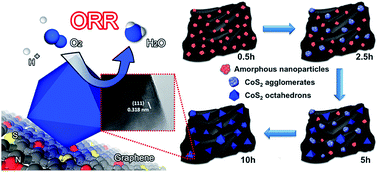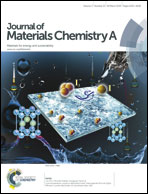Shape-controlled octahedral cobalt disulfide nanoparticles supported on nitrogen and sulfur-doped graphene/carbon nanotube composites for oxygen reduction in acidic electrolyte†
Abstract
Replacement of expensive platinum-based catalysts at the cathode of fuel cells by low-cost alternatives represents an important milestone to achieve significant system cost reductions. In this work, single crystal cobalt disulfide (CoS2) octahedral nanoparticles supported on graphene/carbon nanotube composites were prepared as oxygen reduction reaction (ORR) catalysts in acidic electrolyte. During the simplistic, one-pot solvothermal synthesis, the nanostructured carbon supports were also simultaneously doped with nitrogen and sulfur. Time dependent studies elucidated the growth process of the {111} facet encased octahedra that could only be prepared when carbon support materials were incorporated into the reaction mixture. Through computational simulations, the shape directed growth process was found to be driven thermodynamically towards surface energy minimization. Control experiments and spectroscopy characterization were also used to investigate the occurrence and nature of nitrogen and sulfur doping into the graphitic structure of the graphene/carbon nanotube composite support. The impact of carbon support on ORR activity was clear, with the graphene/carbon nanotube composite supported CoS2 octahedra (CoS2-CG) outperforming CoS2 supported on just graphene or carbon nanotubes. Additionally, CoS2-CG provided an on-set potential (0.78 V vs. RHE) and half-wave potential (0.66 V vs. RHE) that was 60 mV and 150 mV higher than the CoS2 particle agglomerates formed when no carbon support was included during catalyst preparation. This improved activity can be attributed to the beneficial properties of the nitrogen and sulfur doped graphene/carbon nanotube composite support, and also may arise due to the more favourable oxygen adsorption on the (111) surface of the octahedral particles predicted by theoretical calculations. By combining the synergistic properties of the graphene/carbon nanotube composite and unique shape controlled single crystal CoS2 nanoparticles, CoS2-CG is presented as an emerging catalyst for the ORR in fuel cells.


 Please wait while we load your content...
Please wait while we load your content...